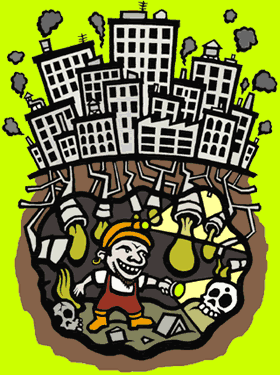
Once, coming of age was a relatively straightforward process. Boys who sought brag-worthy anecdotes that form such an integral part of manhood simply "lit out," Huck Finn-style, for the rivers, caves, and woods beyond the edge of town. But this century has seen the edge of town disappear beneath the soul-hobbling uniformity of suburbia, its adolescent proving grounds displaced by mini-malls. Today's thrill seekers must look in a new direction for uncharted territories: down.
In cities all over the globe postmodern youths spelunk through the Earth's last unexplored realms -- the cellars, subways, and crypts hollowed out beneath many urban centers. From New York City to Moscow to Sydney, Australia, explorers don gum boots, miner's helmets, and waterproof pants before descending into the murky -- and stinky -- underworld. They return with grainy photos and harrowing tales of strange artifacts, toxic waste, and skulking criminals.
"I like being places where other people haven't been. I like seeing things that most people don't see because they're too difficult for most people to get to," says Steve Duncan, a Columbia University student who has explored tunnels beneath Grand Central Station and Riverside Park. "In urban settings, that seems to mean [sites that are] underground or inaccessible in other ways. Then I can tell people about the cool things I've seen."
Duncan's willingness to discuss his experiences places him into one of two general categories of urban explorers. The other, sizable category consists of those who prefer to keep their exploits private lest they draw attention from authorities.
"Generally I don't like being too specific about what I have and haven't infiltrated," says "Pink," an Australian explorer who prefers not to give out a real name. "As soon as it gets out that explorers are getting into certain areas, the sooner these areas are blocked off." But even Pink can't resist the opportunity to brag, adding, "I'm proud of some of the long drain expos [explorer slang for "explorations"] I've done, the train tunnels and the numerous bridges I've infiltrated."
Many, such as the members of Australia's continent-wide Cave Clan and Moscow's Diggers, are even less circumspect. The 13-year-old Cave Clan, of which Pink is a junior member, appears frequently on Australian TV. In Moscow, charismatic Digger leader Vadim Mikhailov has led numerous reporters through pitch-black caverns dripping with industrial and human waste. He's always happy to extol the virtues of his "reverse world" where "aboveground rules no longer apply."
Moscow's long history of authoritarian regimes makes it particularly fertile territory. Perhaps the first-ever urban explorer was 19th-century Russian writer Vladimir Gilyarovsky, who reported on the underground dens built by criminal gangs. Today, Mikhailov says, there are six to 12 levels of sewer systems, abandoned subways, and hidden bunkers under the city, some dating from the era of the czars. The Diggers say they've found corpses, human skulls, deserted laboratories, and evidence of a Stalin-era mass grave in their travels underground.
For explorers in this country the artifacts are generally less dramatic. Like many Americans, Duncan got his start navigating the steam tunnels below his college -- a journey that's become a modern rite of passage for students all over the country. Cyberpunk author Neal Stephenson wrote about a band of tunnel explorers in his first novel, 1984's The Big U, and today students at UCLA, Caltech, MIT, and many other colleges share maps and photos on the Web.
"I'm really intrigued by the history that's evidenced by the artifacts that are hidden away," Duncan says. "In Columbia's tunnels there are old rusted hoppers from when the furnaces ran on coal and a big piece of the cyclotron that split the first atom ever split in America -- both several levels underground."
Like many explorers, Duncan has a wish list of sites he'd like to visit around the world. One of his cherished targets is Chicago, where he believes an old freight train track runs underneath the Loop, 20 feet below the subway. Pink likewise yearns for "big drains, big bridges and big cavities" such as underground army bunkers and drain systems carved through solid rock. "I haven't gone to other countries for the sole purpose of exploration, but I always seem to find a way to get a bit done," Pink says.
One target prized by explorers the world over is the Paris Catacombs. A portion of this historic underground graveyard is open to the public, but "cataphiles" in the know prefer to wander through the 200 miles of unauthorized passageways accessible through secret entrances around the city. A sizeable subculture has grown up around the catacombs, with spelunkers searching for centuries-old graffiti and piles of bones.
Some participate in the annual "cata-sprint," a race designed to prove their knowledge of the labyrinth, and parties held in certain well-known areas have attracted hundreds. But catacomb culture is in danger. The Paris police department's officer in charge of the tunnels, who has long been tolerant of clandestine visitors, is about to retire. In his absence, authorities have begun to levy stiff fines on intruders.
Still, plenty of other hidden treasures remain to tempt amateur explorers. British enthusiasts organize trips to old mines and military sites. Mikhailov's Diggers hope to find the fabled underground library of Ivan the Terrible. Explorers in Toronto navigate the city's extensive system of storm drains, and Australia's Cave Clan invades virtually any abandoned structure it can find. They may look different, but hidden worlds today offer the same pleasures they always have.
Etelka Lehoczky writes regularly for Salon and the Chicago Tribune.
